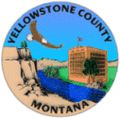Yellowstone County, Montana | |
|---|---|
 Yellowstone County Courthouse in Billings, 2024 | |
 Location within the U.S. state of Montana | |
 Montana's location within the U.S. | |
| Coordinates: 45°56′N108°16′W / 45.94°N 108.27°W | |
| Country | |
| State | |
| Founded | February 26, 1883 |
| Named after | Yellowstone River |
| Seat | Billings |
| Largest city | Billings |
| Area | |
• Total | 2,649 sq mi (6,860 km2) |
| • Land | 2,633 sq mi (6,820 km2) |
| • Water | 16 sq mi (41 km2) 0.6% |
| Population (2020) | |
• Total | 164,731 |
• Estimate (2024) | 171,583 |
| • Density | 62.56/sq mi (24.16/km2) |
| Time zone | UTC−7 (Mountain) |
| • Summer (DST) | UTC−6 (MDT) |
| Congressional district | 2nd |
| Website | www |
| |
Yellowstone County is the most populous county in the U.S. state of Montana. As of the 2020 census, the population was 164,731. [1] Its county seat is Billings, [2] the state's most populous city. Like the nearby national park, Yellowstone County is named after the Yellowstone River which roughly bisects the county, flowing southwest to northeast. [3] The river, in turn, was named for the yellow sandstone cliffs in what is now Yellowstone County. [4]
Contents
- Geography
- Major highways
- Transit
- Adjacent counties
- National protected areas
- Demographics
- 2020 census
- 2010 census
- Politics
- Communities
- Cities
- Town
- Census-designated places
- Other unincorporated communities
- Ghost towns
- Education
- See also
- References
- External links
Yellowstone County is included in the Billings, Montana Metropolitan Statistical Area.

